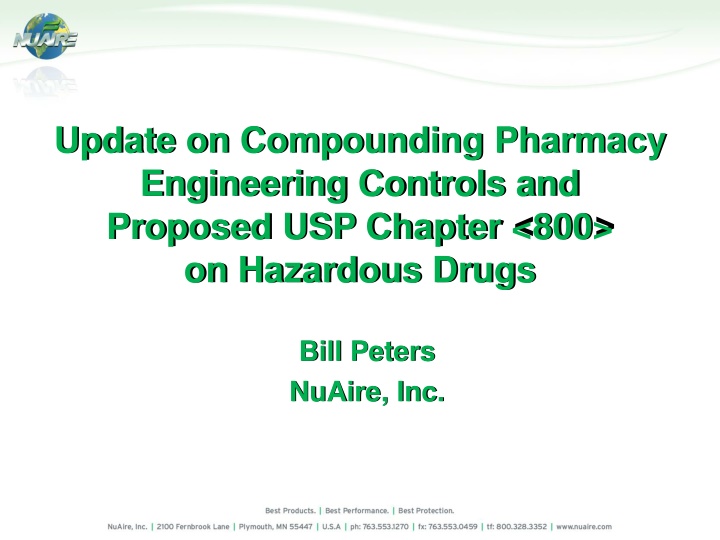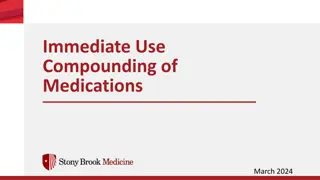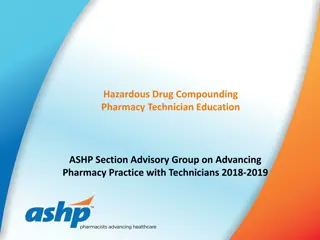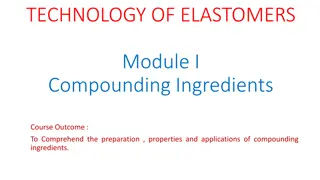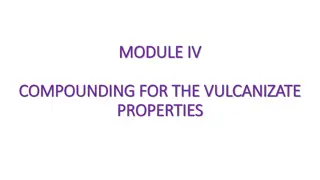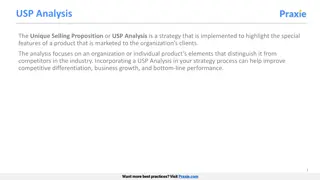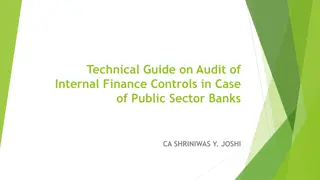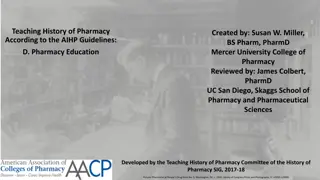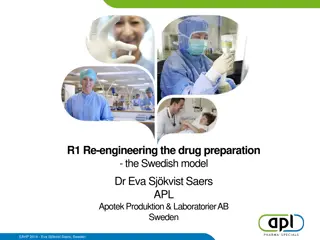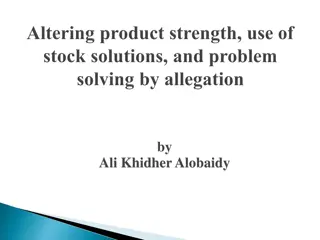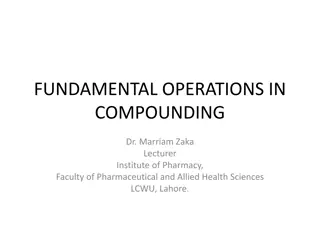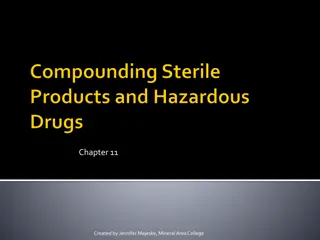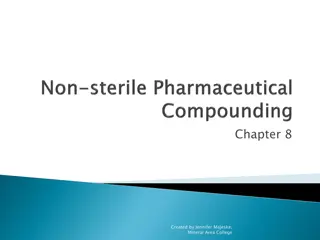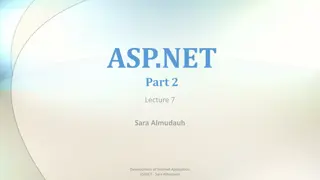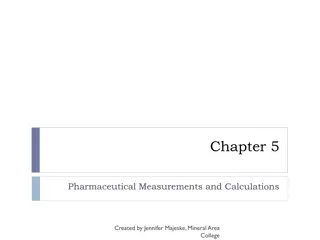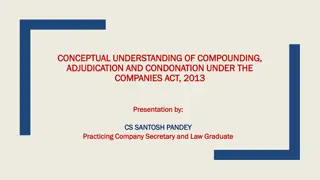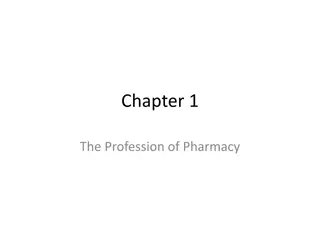Updates on Compounding Pharmacy Engineering Controls and Proposed USP Chapter <800>
This update covers regulatory information related to compounding pharmacy operations, including the Safe Compounding Act of 2013, NABP and state boards of pharmacy regulations, and the proposed USP Chapter <800> on hazardous drug handling in healthcare settings. It emphasizes the need for understanding and compliance with state-specific regulations and highlights key differences between USP Chapter <797> and the proposed USP Chapter <800> facility requirements.
Download Presentation

Please find below an Image/Link to download the presentation.
The content on the website is provided AS IS for your information and personal use only. It may not be sold, licensed, or shared on other websites without obtaining consent from the author.If you encounter any issues during the download, it is possible that the publisher has removed the file from their server.
You are allowed to download the files provided on this website for personal or commercial use, subject to the condition that they are used lawfully. All files are the property of their respective owners.
The content on the website is provided AS IS for your information and personal use only. It may not be sold, licensed, or shared on other websites without obtaining consent from the author.
E N D
Presentation Transcript
Update on Compounding Pharmacy Engineering Controls and Proposed USP Chapter <800> on Hazardous Drugs Bill Peters NuAire, Inc.
COMPOUNDING REGULATORS Safe Compounding Act of 2013 Gives FDA authority for compounding Over 80 483s and warning letters issued to what will be considered FDA outsourcing facilities 503A Traditional compounders (prescription based) falling under their respective state pharmacy board 503B FDA Registered outsourcing facilities
NABP AND INDIVIDUAL STATE BOPS National Association Boards of Pharmacy (NABP) Support State Boards of Pharmacy Aid in creation of certification regulations Provides Pharmacist Accreditation Not a regulatory body
STATEBOARDSOFPHARMACY(BOPS ) Each State BOP adopts their own regulations from USP all or in part Each State provides their own inspection & enforcement Know your State BOP regulations! http://www.clinicaliq.com/797-state-survey For example in Texas for low and medium risk CSPs Allows use of CAI outside in ISO Class 7 room if meets the criteria in USP 797 However, their rules interpretation requires an ISO Class 8 Ante-Area with hands free sink operation and full garb for all compounding regardless of meeting criteria for CAI use
STATEBOARDSOFPHARMACY(BOPS ) Inspector Training Critical Point Training Knowledge of Engineering Controls Knowledge and demonstration of first air Reference Certification Cards (see attachment) Trend toward requiring CAG-003 and Accredited Certifiers
PROPOSED USP CHAPTER <800> Hazardous Drug Handling in Healthcare Settings Released for public comment March 28, 2014 http://www.usp.org/usp-nf/notices/compounding-notice Reference NIOSH Hazardous Drug Lists http://www.cdc.gov/niosh/topcis/hazardous
PROPOSED USP CHAPTER <800> Facility requirements that differ from the current USP general chapter <797> include the following: 1. Elimination of the low volume exemption All hazardous drug compounding shall be done in a separate area designated for hazardous drug compounding 2. Allowance for a Containment Segregated Compounding Area (C-SCA) a separate, negative pressure room with at least 12 air changes per hour for use with compounding hazardous drugs Note: The differences will be reconciled to a revised <797> Note: <800> will be harmonized with the NIOSH alert
PROPOSED USP CHAPTER <800> <800> will support sterile & non-sterile compounding <797> <795>
PROPOSED USP CHAPTER <800> 1. Introduction 2. List of Hazardous Drugs 3. Types of Exposure 4. ResponsibilitiesofPersonnelHandlingHazardousDrugs 5. Facility Design and Engineering Controls 6. Personal Protective Equipment 7. Hazard Communication Program 8. Training for Compounding Personnel 9. Receiving 10. Transporting
PROPOSED USP CHAPTER <800> 11. Dispensing HD Dosage Forms Not Requiring Alteration 12. Compounding HD Dosage Forms 13. Protection When Administering HDs 14. Cleaning: Deactivation, Decontamination, Cleaning, and Disinfection 15. Spill Control 16. Disposal 17. Environmental Quality and Control 18. Documentation 19. Medical Surveillance
PROPOSED USP CHAPTER <800> Appendices a. Acronyms and Definitions b. Suggested Standard Operating Procedures (SOPs) c. Types of Biological Safety Cabinets (BSCs) d. Best Practices for Handling HDs e. ExamplesforDesignofHazardousDrugCompoundingAreas f. Requirements for Personal Protective Equipment (PPE)
PROPOSED USP CHAPTER <800> Selected Acronyms CETA CFR C-PEC Containment primary engineering control C-SCA Containment segregated compounding area C-SEC Containment secondary engineering control CSP Compounded sterile preparation CSTD Closed system drug-transfer device CVE Containment ventilated enclosure Controlled Environment Testing Association Code of Federal Regulations
PROPOSED USP CHAPTER <800> Selected Definitions Containment Primary Engineering Control (C-PEC): A ventilated device designed and operated to minimize worker and environmental exposures to HDs by controlling emissions of airborne contaminants through the following: Containment Secondary Engineering Control (C-SEC): The C-SEC is the room in which the C-PEC is placed. It incorporates specific design and operational parameters required to contain the potential hazard within the compounding room, e.g., restricted access, barriers, special construction technique, ventilation, and room pressurization are components of the secondary control strategy.
PROPOSED USP CHAPTER <800> Selected Definitions (continued) Containment Segregated Compounding Area (C-SCA): A type of C-SEC with nominal airflow and room pressurization requirements as they pertain to HD compounding. The C-SCA is limited for use with a BSC when preparing low- or medium-risk level CSPs with 12-hour or less BUDs, preparing CSPs in a CACI that meets the requirements in 797, or preparing of non-sterile HDs in a C-PEC. Containment Ventilated Enclosure (CVE): A full or partial enclosure that uses ventilation principles to capture, contain, and remove airborne contaminants (through HEPA filtration) and prevent their release into the work environment (see Table 2).
PROPOSED USP CHAPTER <800> Selected Definitions (Continued) Supplemental Engineering Control: An adjunct control (e.g., CSTD) used in concurrence with primary and secondary control strategies. Supplemental engineering controls offer additional levels of protection and may facilitate enhanced occupational protection because the HD is handled outside of the protective controls of primary and secondary control environments (e.g., post- compounding transit, administration, and disposal).
PROPOSED USP CHAPTER <800> Facility Design and Engineering Controls (5.0) Storage of HDs (5.2) Engineering Controls (5.3) Non-Sterile Compounding (5.4) Sterile Compounding (5.5) Combined: Non-Sterile and Sterile Compounding (5.6) Containment Supplemental Engineering controls (5.7) Closed System Transfer Devices (CSTDs)
NOTESON STORAGE (5.2 STORAGEOF HDS) Unless the HDs already exist in their final unit dose or unit-of- use packaging, HDs shall be stored separately from other inventory in a manner to prevent contamination and personnel exposure, which includes storage in a negative pressure room with at least 12 air changes per hour (ACPH). Depending upon pharmacy design, HD storage within the HD buffer area can fulfill this storage criterion.
NOTESON SECONDARYENGINEERINGCONTROLS (5.2 ENGINEERING CONTROLS) HDs that require alteration shall be manipulated (mixed, diluted, compounded, and others) in a C-PEC in an area that is physically separated from other preparation areas, that is under negative pressure, and has at least 12 ACPH. Additional criteria are listed below. minimum negative pressure of 0.01 inches of water column.
NOTESON NON-STERILEHDCOMPOUNDING (5.4 NON-STERILE COMPOUNDING) Table 3. Acceptable Configuration for Non-sterile HD Compounding FUNCTION C-PEC S-SEC AIRFLOW MAXIMUM BUD Non-sterile compounding Any C-PEC C-SEC 12 ACPH (exhaust) As listed in <795>
NOTESON BSC (5.5 STERILE HD COMPOUNDING) Class II BSC, Types A2, B1, or B2 are all acceptable; however, for most known HDs, Type A2 cabinets offer a simple and reliable integration with the ventilation and pressurization requirements of the secondary engineering control. Class II Type B2 BSCs are typically reserved for use with highly volatile components.
NOTESON BSC (5.5 STERILE HD COMPOUNDING) Table 4. Acceptable Configuration for Sterile-to-Sterile HD Compounding MAXIMUM BUD CONFIGURATION FUNCTION C-PEC C-SEC AIRFLOW 30 ACPH (HEPA supply) Compounding sterile HD in a Cleanroom BSC or CACI ISO 7 Cleanroom As listed in <797> 1 Compounding sterile HD in a CACI that meets the requirements listed in <797> 12 ACPH (exhaust) As listed in <797> 2 CACI C-SCA Compounding low or medium-risk sterile HDs in a BSC. [Note This configuration is not acceptable for high-risk sterile HD compounding] 12 ACPH (exhaust) 3 BSC C-SCA 12 hours
PROPOSED USP CHAPTER <800> Appendix E: Examples for Design of Hazardous Drug Compounding Areas
PROPOSED USP CHAPTER <800> Appendix E: Examples for Design of Hazardous Drug Compounding Areas
ACKNOWLEDGEMENTS Jim Wagner
